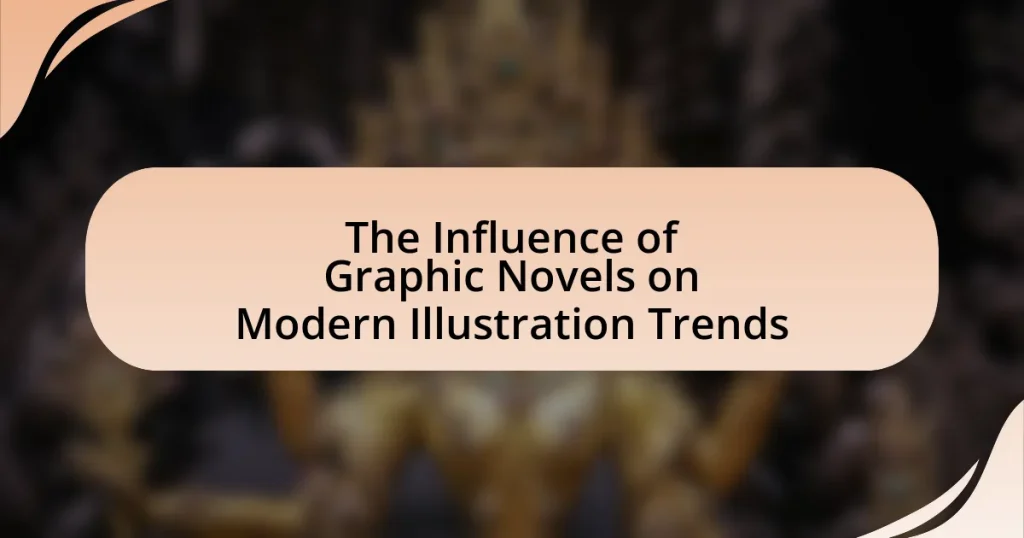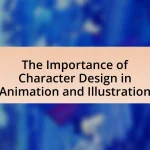The article examines the significant influence of graphic novels on modern illustration trends, highlighting how they have popularized diverse visual storytelling techniques and styles. It discusses the evolution of graphic novels from niche markets to mainstream acceptance, the key factors contributing to their rise, and their impact on contemporary illustration aesthetics. The article also explores unique storytelling techniques employed in graphic novels, their role in shaping character design, and the cultural implications of their narratives. Additionally, it addresses future trends in graphic novels and their potential to inspire new techniques in illustration, providing practical tips for illustrators to incorporate graphic novel methods into their work.
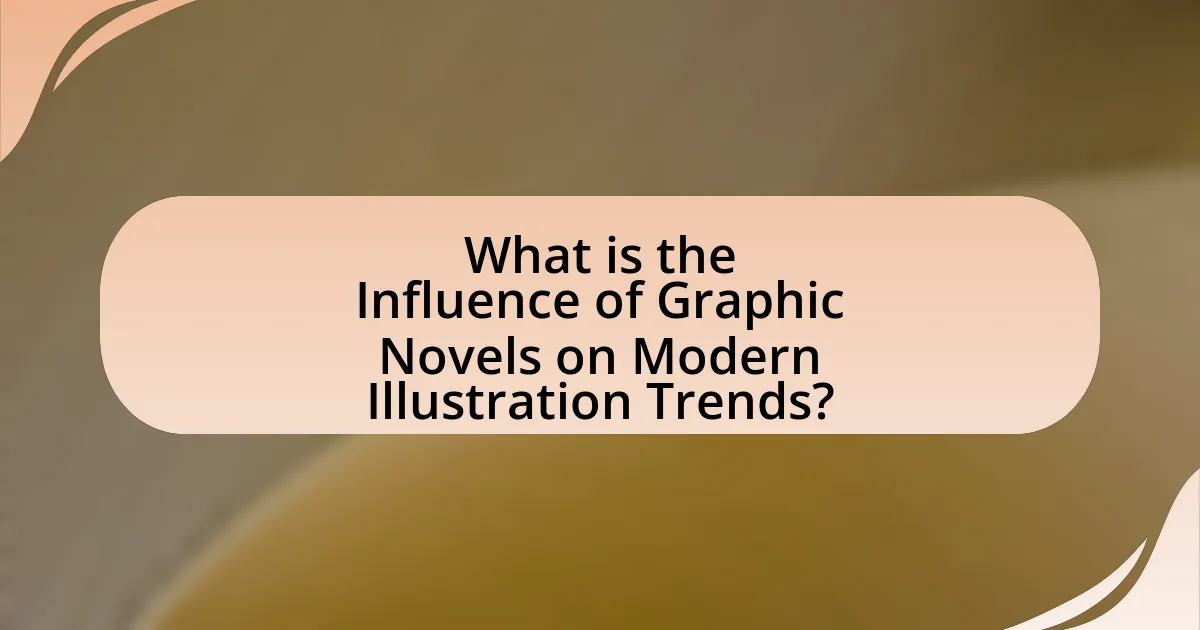
What is the Influence of Graphic Novels on Modern Illustration Trends?
Graphic novels significantly influence modern illustration trends by popularizing diverse visual storytelling techniques and styles. This impact is evident in the increasing incorporation of dynamic panel layouts, expressive character designs, and a blend of traditional and digital art forms in contemporary illustrations. For instance, the rise of graphic novels has led to a greater acceptance of varied artistic styles, such as manga and indie comics, which have inspired illustrators to experiment with color palettes and narrative structures. Additionally, the success of graphic novels like “Maus” by Art Spiegelman and “Persepolis” by Marjane Satrapi has validated the medium as a serious art form, encouraging illustrators to explore complex themes and social issues through their work. This shift has resulted in a richer, more inclusive landscape in modern illustration, reflecting a broader range of cultural narratives and artistic expressions.
How have graphic novels evolved in recent years?
Graphic novels have evolved significantly in recent years, transitioning from niche markets to mainstream acceptance and recognition. This evolution is evidenced by the increasing number of graphic novels being nominated for prestigious literary awards, such as the Pulitzer Prize and the Eisner Awards, which highlights their literary merit. Additionally, the diversity of themes and genres has expanded, with graphic novels now addressing complex social issues, personal narratives, and experimental storytelling techniques. The rise of digital platforms has also facilitated broader distribution and accessibility, allowing creators to reach wider audiences and experiment with interactive formats. This shift reflects a growing recognition of graphic novels as a legitimate form of artistic expression and storytelling.
What key factors have contributed to the rise of graphic novels?
The key factors that have contributed to the rise of graphic novels include the increasing acceptance of the medium as a legitimate form of literature, the expansion of diverse genres appealing to a broader audience, and advancements in printing technology that have made production more accessible. The recognition of graphic novels in literary awards, such as the Eisner Awards, has validated their status, while titles like “Maus” and “Persepolis” have showcased their potential for storytelling. Additionally, the growth of digital platforms has facilitated wider distribution and readership, further enhancing their popularity.
How do graphic novels differ from traditional comics?
Graphic novels differ from traditional comics primarily in their narrative structure and length. Graphic novels typically present a complete story in a single volume, allowing for more complex character development and thematic depth, while traditional comics often consist of shorter, episodic stories published in serial format. This distinction is supported by the fact that graphic novels can explore intricate plots and character arcs over hundreds of pages, as seen in works like “Maus” by Art Spiegelman, which delves into historical trauma, whereas traditional comics, such as superhero series, often focus on action and adventure in shorter installments.
Why are graphic novels significant in the world of illustration?
Graphic novels are significant in the world of illustration because they combine visual art and narrative storytelling, creating a unique medium that enhances both forms. This integration allows for complex themes and character development to be conveyed through a combination of images and text, making the storytelling more immersive. The rise of graphic novels has influenced modern illustration trends by encouraging artists to explore diverse styles and techniques, as seen in works like “Maus” by Art Spiegelman, which won a Pulitzer Prize, showcasing the potential of graphic novels to address serious subjects. Additionally, the popularity of graphic novels has led to increased recognition of illustrators as legitimate authors, further solidifying their importance in contemporary visual culture.
What unique storytelling techniques do graphic novels employ?
Graphic novels employ unique storytelling techniques such as visual narrative, panel transitions, and the integration of text and imagery. Visual narrative allows readers to interpret the story through illustrations, creating a dynamic experience that combines art and literature. Panel transitions guide the pacing and flow of the story, influencing how time and action are perceived; for example, a series of panels can depict a moment in time or a significant jump in narrative. The integration of text and imagery enhances storytelling by providing context, dialogue, and emotional depth, as seen in works like “Maus” by Art Spiegelman, where the combination of visuals and text conveys complex themes of memory and trauma. These techniques distinguish graphic novels from traditional prose, making them a unique medium for storytelling.
How do graphic novels influence visual aesthetics in illustration?
Graphic novels significantly influence visual aesthetics in illustration by integrating diverse artistic styles and narrative techniques that reshape conventional visual storytelling. Their unique combination of text and imagery encourages illustrators to experiment with layout, color palettes, and character design, often leading to a more dynamic and expressive form of art. For instance, the use of bold lines and vibrant colors in graphic novels like “Scott Pilgrim” by Bryan Lee O’Malley has inspired illustrators to adopt similar techniques, enhancing the emotional impact of their work. Additionally, the sequential art format of graphic novels promotes a rhythm and pacing in illustration that can influence how visual narratives are constructed across various media, including advertising and animation. This cross-pollination of ideas demonstrates the profound effect graphic novels have on evolving visual aesthetics in contemporary illustration.
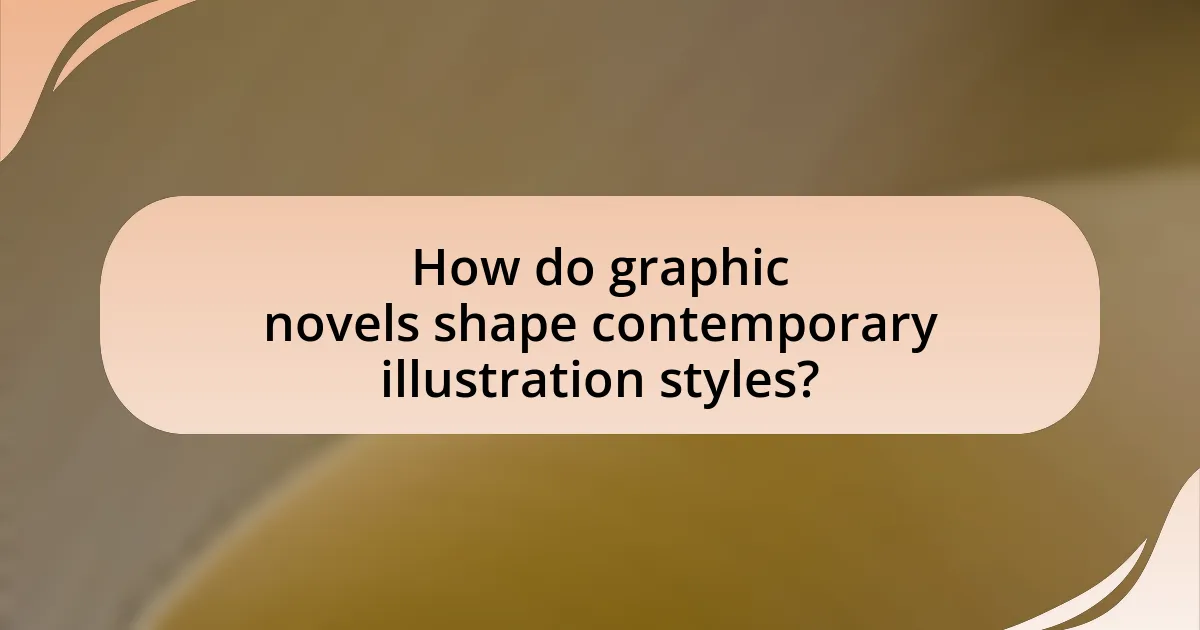
How do graphic novels shape contemporary illustration styles?
Graphic novels significantly shape contemporary illustration styles by introducing diverse narrative techniques and visual aesthetics that influence artists across various mediums. The integration of sequential art, dynamic panel layouts, and a blend of text and imagery in graphic novels encourages illustrators to experiment with storytelling methods, leading to innovative styles that prioritize visual engagement. For instance, the popularity of graphic novels like “Maus” by Art Spiegelman and “Persepolis” by Marjane Satrapi has inspired a wave of illustrators to adopt a more expressive and personal approach to their work, often incorporating elements of realism and abstraction. This evolution is evident in the rise of hybrid genres that merge traditional illustration with graphic novel techniques, reflecting a broader cultural acceptance of graphic storytelling as a legitimate art form.
What are the main illustration trends influenced by graphic novels?
The main illustration trends influenced by graphic novels include dynamic panel layouts, expressive character design, and the use of vibrant color palettes. Dynamic panel layouts allow for non-linear storytelling, enhancing visual engagement and pacing, which is a hallmark of graphic novels. Expressive character design emphasizes individuality and emotional depth, often utilizing exaggerated features to convey personality traits. Additionally, vibrant color palettes are employed to evoke mood and atmosphere, drawing from the rich visual language established in graphic novels. These trends reflect the narrative and artistic techniques that have emerged from the graphic novel medium, shaping contemporary illustration practices across various platforms.
How do color palettes in graphic novels affect modern illustrations?
Color palettes in graphic novels significantly influence modern illustrations by establishing emotional tones and visual storytelling techniques. Graphic novels often utilize specific color schemes to evoke particular feelings, which contemporary illustrators adopt to enhance narrative depth. For instance, the use of muted colors can convey melancholy, while vibrant hues may suggest excitement or joy. This practice is evident in works like “Watchmen” by Alan Moore and Dave Gibbons, where the color palette directly impacts the story’s mood and themes. As a result, modern illustrators increasingly incorporate similar strategies, drawing from the established conventions of graphic novels to create compelling visual narratives that resonate with audiences.
What role does character design in graphic novels play in illustration trends?
Character design in graphic novels significantly influences illustration trends by establishing visual language and stylistic norms that resonate across various media. This design approach often sets benchmarks for character representation, impacting how artists conceptualize and execute their work. For instance, the unique styles seen in graphic novels like “Scott Pilgrim” by Bryan Lee O’Malley have inspired a wave of minimalist and retro aesthetics in contemporary illustration. Additionally, character design in graphic novels often emphasizes diversity and representation, which has led to broader acceptance and incorporation of varied character designs in mainstream illustration, reflecting societal changes and audience expectations.
How do graphic novels impact the work of modern illustrators?
Graphic novels significantly influence the work of modern illustrators by expanding narrative techniques and visual storytelling methods. This impact is evident as illustrators increasingly adopt the combination of text and imagery to convey complex themes and emotions, a hallmark of graphic novels. For instance, the success of graphic novels like “Maus” by Art Spiegelman and “Persepolis” by Marjane Satrapi has led to a broader acceptance of illustrated narratives in various genres, encouraging illustrators to experiment with styles and formats that blend traditional illustration with contemporary storytelling. This shift is supported by the rise of graphic novel courses in art schools, which emphasize the importance of sequential art, thereby shaping the skills and approaches of new generations of illustrators.
What skills do illustrators gain from studying graphic novels?
Illustrators gain a variety of skills from studying graphic novels, including visual storytelling, character design, and composition techniques. Visual storytelling enables illustrators to convey narratives effectively through images, enhancing their ability to communicate complex ideas succinctly. Character design skills are developed as illustrators learn to create distinctive and relatable characters that resonate with audiences. Additionally, studying the composition techniques used in graphic novels helps illustrators understand how to arrange visual elements to guide the viewer’s eye and create dynamic layouts. These skills are essential in modern illustration, where narrative and visual engagement are crucial for capturing audience interest.
How do graphic novels inspire new techniques in illustration?
Graphic novels inspire new techniques in illustration by blending visual storytelling with diverse artistic styles, encouraging illustrators to experiment with form and narrative. This medium often incorporates mixed media, dynamic layouts, and innovative use of color, which challenges traditional illustration methods. For instance, works like “Maus” by Art Spiegelman and “Persepolis” by Marjane Satrapi have demonstrated how graphic novels can convey complex themes through unique visual approaches, influencing contemporary illustrators to adopt similar techniques in their own work. The success of graphic novels has led to a broader acceptance of varied artistic expressions in mainstream illustration, fostering a culture of creativity and innovation.
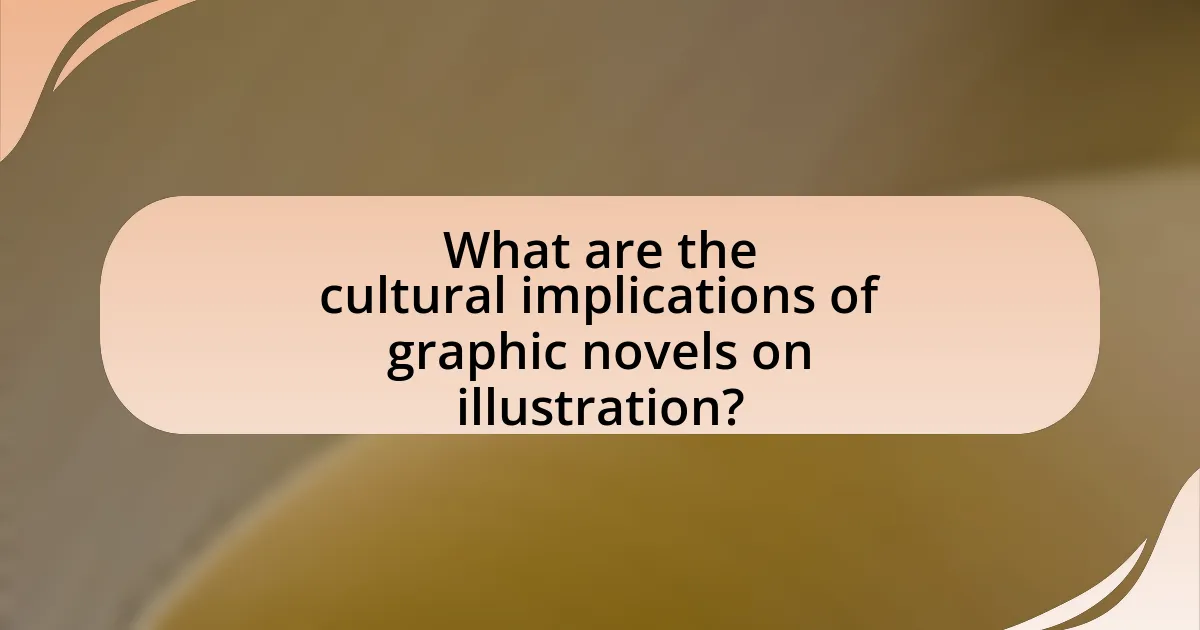
What are the cultural implications of graphic novels on illustration?
Graphic novels significantly influence illustration by broadening the narrative scope and visual language used in the medium. This impact is evident as graphic novels incorporate diverse storytelling techniques, merging text and imagery to convey complex themes and emotions, which traditional illustration often lacks. For instance, the success of graphic novels like “Maus” by Art Spiegelman and “Persepolis” by Marjane Satrapi has led to increased recognition of the graphic novel format as a legitimate art form, influencing illustrators to adopt similar narrative depth and stylistic experimentation in their work. Furthermore, the rise of graphic novels has encouraged inclusivity in representation, prompting illustrators to explore varied cultural perspectives and social issues, thereby enriching the overall landscape of visual storytelling.
How do graphic novels reflect societal issues through illustration?
Graphic novels reflect societal issues through illustration by visually representing complex themes such as identity, inequality, and social justice. These illustrations often depict real-world scenarios, allowing readers to engage with and understand societal challenges on a deeper emotional level. For instance, works like “Maus” by Art Spiegelman address the Holocaust, while “Persepolis” by Marjane Satrapi explores the Iranian Revolution, both using powerful imagery to convey the gravity of these issues. The use of visual storytelling in graphic novels makes abstract concepts more accessible, fostering empathy and awareness among readers.
What themes in graphic novels resonate with contemporary audiences?
Themes in graphic novels that resonate with contemporary audiences include identity, social justice, mental health, and the exploration of diverse cultures. These themes reflect current societal issues and personal experiences, making them relatable to readers. For instance, graphic novels like “Ms. Marvel” address identity and representation, while works such as “March” highlight social justice movements. Additionally, titles like “Fun Home” delve into mental health and family dynamics, showcasing the complexity of personal narratives. The prevalence of these themes in popular graphic novels indicates their significance in engaging modern readers and fostering discussions around relevant topics.
How do graphic novels challenge traditional illustration norms?
Graphic novels challenge traditional illustration norms by integrating complex narratives with visual storytelling, allowing for a more dynamic interplay between text and image. This format diverges from conventional illustration, which often prioritizes standalone images or simplistic narratives. For instance, graphic novels like “Maus” by Art Spiegelman and “Persepolis” by Marjane Satrapi utilize unique artistic styles and layouts to convey deeper emotional and thematic content, thus redefining the boundaries of visual art. The combination of diverse artistic techniques and layered storytelling in graphic novels has influenced modern illustration trends, encouraging artists to explore innovative forms of expression that blend visual art with literary elements.
What future trends can we expect from the influence of graphic novels?
Future trends influenced by graphic novels include increased integration of visual storytelling in various media, such as film, video games, and digital platforms. This trend is supported by the growing popularity of graphic novels, which have seen a significant rise in sales, with the market reaching over $1 billion in the U.S. in 2020, according to the NPD Group. Additionally, the blending of genres, where graphic novels incorporate elements from traditional literature, will likely continue, fostering a more diverse narrative style. The educational sector is also expected to adopt graphic novels more widely as effective teaching tools, enhancing engagement and comprehension among students.
How might technology shape the evolution of graphic novels and illustration?
Technology will significantly shape the evolution of graphic novels and illustration by enabling new forms of storytelling and artistic expression. Digital tools, such as graphic tablets and software like Adobe Illustrator, allow artists to create intricate designs and streamline the production process, resulting in higher quality visuals. Additionally, advancements in augmented reality (AR) and virtual reality (VR) provide immersive experiences that can enhance narrative engagement, as seen in projects like “The Night Cafe,” which transforms classic art into interactive environments. Furthermore, online platforms facilitate global distribution and audience interaction, exemplified by webcomics that reach diverse demographics and foster community feedback. These technological innovations not only expand creative possibilities but also redefine how graphic novels are consumed and appreciated in contemporary culture.
What emerging styles are likely to develop from graphic novel influences?
Emerging styles likely to develop from graphic novel influences include hybrid visual storytelling, which combines traditional illustration with digital techniques, and narrative-driven art that emphasizes character development and emotional depth. These styles are increasingly seen in contemporary illustrations, where artists draw inspiration from the sequential art and thematic complexity of graphic novels. For instance, the rise of webcomics has led to a fusion of animation and static art, creating dynamic visual experiences that engage audiences in new ways. This trend reflects the growing acceptance of graphic novels as a legitimate art form, influencing illustrators to adopt similar narrative structures and stylistic elements in their work.
What practical tips can illustrators learn from graphic novels?
Illustrators can learn several practical tips from graphic novels, including the importance of visual storytelling, character development, and pacing. Visual storytelling emphasizes the need to convey narratives through images, allowing illustrators to create compelling scenes that engage viewers. Character development teaches illustrators to design characters with distinct personalities and visual traits, enhancing relatability and depth. Pacing, as demonstrated in graphic novels, highlights the significance of panel arrangement and timing in guiding the reader’s experience, ensuring that the flow of the story is both engaging and coherent. These elements are foundational in graphic novels and can significantly enhance an illustrator’s work by fostering a deeper connection with the audience.
How can illustrators incorporate graphic novel techniques into their work?
Illustrators can incorporate graphic novel techniques into their work by utilizing sequential art, dynamic panel layouts, and visual storytelling methods. Sequential art allows illustrators to convey narratives through a series of images, enhancing the storytelling aspect of their illustrations. Dynamic panel layouts, which vary in size and shape, create visual interest and guide the viewer’s eye, making the artwork more engaging. Additionally, employing visual storytelling techniques, such as the use of symbolism and character expressions, can deepen the emotional impact of the illustrations. These methods are foundational in graphic novels, as seen in works like “Maus” by Art Spiegelman, which effectively combines these techniques to tell complex stories.
What resources are available for illustrators to study graphic novels?
Illustrators can study graphic novels through a variety of resources, including books, online courses, workshops, and academic programs. Notable books such as “Understanding Comics” by Scott McCloud provide foundational knowledge on the medium, while online platforms like Skillshare and Coursera offer courses specifically focused on graphic novel creation and illustration techniques. Additionally, workshops hosted by organizations like the Society of Children’s Book Writers and Illustrators (SCBWI) provide hands-on experience and networking opportunities. Academic programs at institutions like the School of Visual Arts and California College of the Arts offer structured curricula that delve into graphic novel studies, combining theory and practice. These resources collectively enhance illustrators’ understanding of graphic novels and their impact on modern illustration trends.
